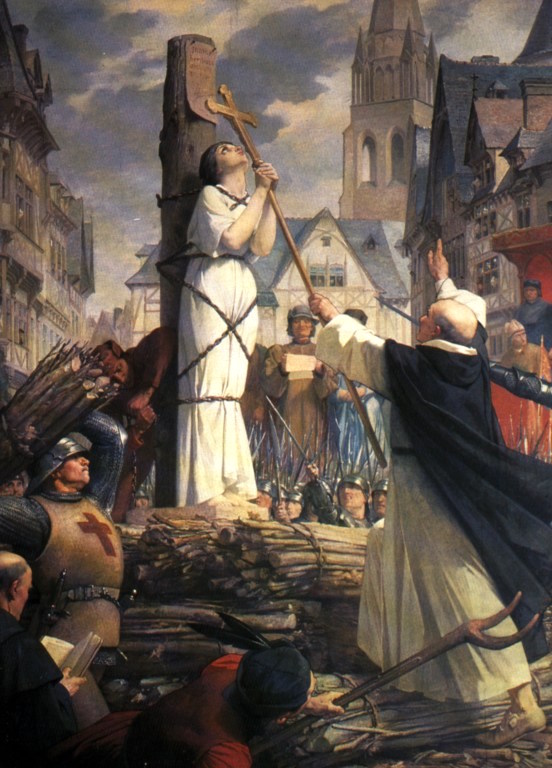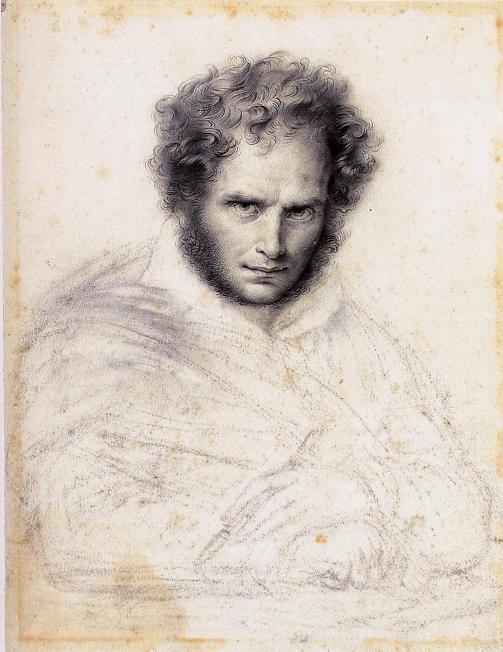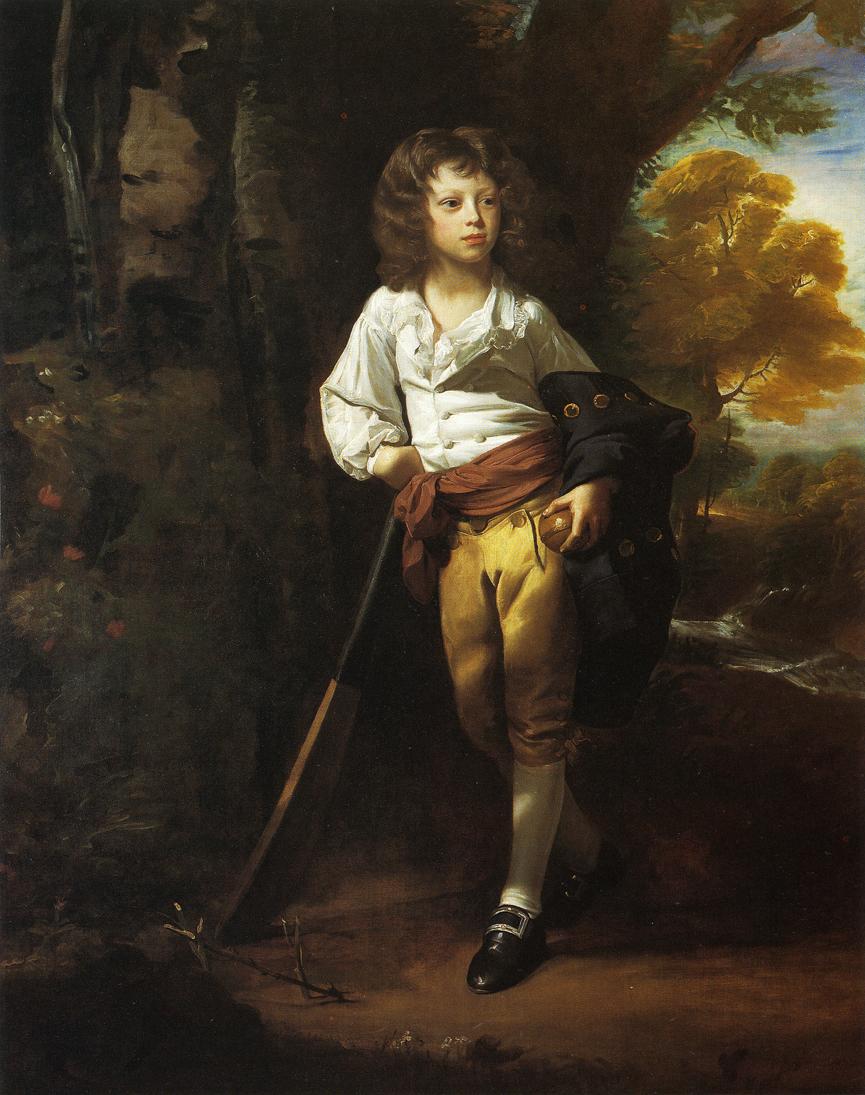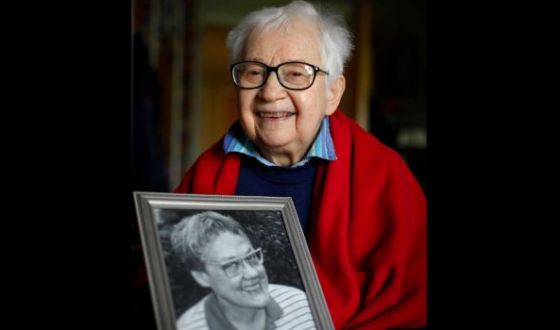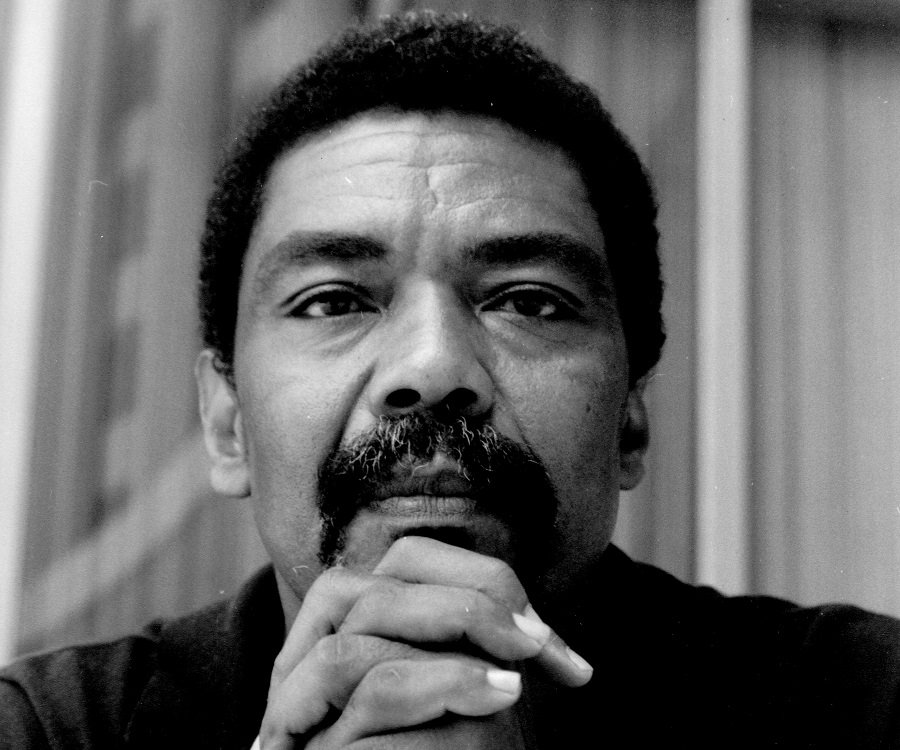January 05
JOAN OF ARC, Roman Catholic Saint and national heroine of France (this is a legendary date) (d. 1431); Back in the day when the Roman Catholic Church had a say in what women wore, Joan wore men's clothing between her departure from Vaucouleurs and her abjuration at Rouen.
This raised theological questions in her own era and raised other questions in the twentieth century. The technical reason for her execution was a biblical clothing law. The nullification trial reversed the conviction in part because the condemnation proceeding had failed to consider the doctrinal exceptions to that stricture.
Doctrinally speaking, she was safe to disguise herself as a page during a journey through enemy territory and she was safe to wear armor during battle. The Chronique de la Pucelle states that it deterred molestation while she was camped in the field. Clergy who testified at her rehabilitation trial affirmed that she continued to wear male clothing in prison to deter molestation and rape. Preservation of chastity was another justifiable reason for cross-dressing: her apparel would have slowed an assailant, and men would be less likely to think of her as a sex object in any case.
She referred the court to the Poitiers inquiry when questioned on the matter during her condemnation trial. The Poitiers record no longer survives but circumstances indicate the Poitiers clerics approved her practice. In other words, she had a mission to do a man's work so it was fitting that she dress the part. She also kept her hair cut short through her military campaigns and while in prison. Her supporters, such as the theologian Jean Gerson, defended her hairstyle, as did Inquisitor Brehal during the Rehabilitation trial.
Because Joan wore men's clothes and armor, scholars have speculated about her gender identity and sexuality. Did Joan wear male apparel because she was transgendered? Or did she do so in order to be taken seriously by the men whose support she needed to carry out the orders given by her visions? Was Joan a lesbian or bisexual, if those English terms may be applicable to a French woman living almost six hundred years ago? What relationship did her gender expression have with her sexuality? What about Joan's emphasis throughout her life on her virginity?
It is difficult adequately to address these personal issues based on the historical evidence that we now possess. It is clear, however, that Joan's cross-dressing was a significant part of her life, and that as a cross-dressed warrior and military leader she was venerated by French royalty, soldiery, and peasantry alike.
On this date the French painter ANNE-LOUIS GIRODET DE ROUSSY-TRIOSON (also known as Anne-Louis Girodet de Roucy-Triosson, Anne-Louis Girodet-Trioson) was born (d.1824). He was a pupil of the great Romantic painter Jacques-Louis David, famed for adding elements of eroticism through his paintings.
Girodet is remembered for his precise and clear style and for his paintings of members of the Napoleonic family. Girodet: Romantic Rebel at The Art Institute of Chicago (2006), was the first retrospective in the United States devoted to the works of Anne-Louis Girodet de Roussy-Trioson. The exhibition assembled more than 100 seminal works (about 60 paintings and 40 drawings) that demonstrated the artist’s range as a painter as well as a draftsman.
RICHARD HEBER, British bibliophile, born (d: 1833); Anyone who has been privileged to attend a meeting of a certain famous bibliophilic club on the East Coast, realizes in a flash that a majority of the tuxedo clad gentleman gathered to discuss their common passion – book collecting – is rich, recondite, Republican and remarkably Gay. Their ancestor of ancestors was English book collector Richard Heber, who made a habit of attending continental book sales, sometimes purchasing a single book, sometimes entire libraries.
As an undergraduate at Brasenose College, Oxford, Richard Heber began to collect a purely classical library, but his taste broadening, he became interested in early English drama and literature, and began his wonderful collection of rare books in these departments. He attended continental book sales, purchasing sometimes single volumes, sometimes whole libraries. Sir Walter Scott, whose intimate friend he was, and who dedicated to him the sixth canto of Martnion, classed Heber's library as "superior to all others in the world"; Campbell described him as "the fiercest and strongest of all the "bibliomaniacs."
He did not confine himself to the purchase of a single copy of a work which took his fancy. "No gentleman," he famously remarked, "can be without three copies of a book, one for show, one for use, and one for borrowers."
To such a size did his library grow that it over-ran eight houses, some in England, some on the Continent. It is estimated to have cost over £100,000, and after his death the sale of that part of his collection stored in England realized more than £56,000.
He is known to have owned 150,000 volumes, and probably many more. He possessed extensive landed property in Shropshire and Yorkshire, and was sheriff of the former county in 1821. He was member of Parliament for Oxford University from 1821-1826, and in 1822 was made a D.C.L. of that University. He was one of the founders of the Athenaeum Club, London. He was forced to leave England in exile after public disclosure of his “unnatural acts.”
KAY LAHUSEN (also known as Kay Tobin), was born on this date (d: 2021), and is considered the first openly Gay photojournalist of the Gay Rights movement. Lahusen's photographs of Lesbians appeared on several of the covers of The Ladder from 1964 to 1966 while her partner, Barbara Gittings, was the editor. Lahusen helped with the founding of the original Gay Activists Alliance (GAA) in 1970, she contributed to a New York-based weekly newspaper named Gay Newsweekly, and co-authored The Gay Crusaders with Randy Wicker.
Lahusen was born and brought up in Cincinnati, Ohio and developed her interest in photography as a child. "Even as a kid I liked using a little box camera and pushing it and trying to get something artsy out of it," she recalled. She discovered while in college that she had romantic feelings for a woman and she had a relationship with her for six years, but after the woman left "in order to marry and have a normal life," Lahusen was devastated by the loss.
Lahusen spent the next six years in Boston working in the reference library of the Christian Science Monitor. She met Barbara Gittings in 1961 at a Daughters of Bilitis picnic in Rhode Island. They became a couple and Lahusen moved to Philadelphia to be with Gittings. When Gittings took over The Ladder in 1963, Lahusen made it a priority to improve the quality of art on the covers. Where previously there were simple line drawings, characterized by Lahusen as "pretty bland, little cats, insipid human figures,"
Lahusen began to add photographs of real lesbians on the cover beginning in September 1964. The first showed two women from the back, on a beach looking out to sea. But Lahusen really wanted to add full-face portraits of lesbians. "If you go around as if you don't dare show your face, it sends forth a terrible message," Lahusen remembered. Several covers showed various women willing to pose in profile, or in sunglasses, but in January 1966 she was finally able to get a full face portrait. Lilli Vincenz, open and smiling, adorned the cover of The Ladder. By the end of Gittings' period as editor, Lahusen remembered there was a waiting list of women who wanted to be full-face on the cover of the magazine. Lahusen also wrote articles in The Ladder under the name Kay Tobin, a name she picked out of the phone book, and which she found was easier for people to pronounce and remember..
Lahusen photographed Gittings and other people who picketed federal buildings and Independence Hall in the mid to late 1960s. She contributed photographs and articles to Gay Newsweekly, and worked in New York City’s Oscar Wilde Memorial Bookstore, the first bookstore devoted to better literature on gay themes, and to disseminating materials that promoted a gay political agenda. She worked with Gittings in the gay caucus of the American Library Association, and photographed thousands of activists, marches, and events in the 1960s and 1970s. Frank Kameny and Jack Nichols and many other gay activists became her subjects.
More recently, her photographs were featured in exhibits at The William Way Community Center in Philadelphia and the Wilmington Institute Library in Delaware. In 2007, all of Lahusen's photos and writings and Gittings' papers and writings were donated to the New York Public Library.
Lahusen and Gittings were together for 46 years when Gittings died of breast cancer on February 18, 2007. Lahusen died in 2021 after a brief illness. She and Gittings are interred at the Congressional Cemetery in Washington D.C. inside a stone bench engraved with the motto they helped popularize: "Gay is good."
On this date the African-American director, dancer and choreographer ALVIN AILEY was born (d. 1989) Best known as the founder of the still flourishing Alvin Ailey American Dance Theater
in New York, Ailey is credited with popularizing modern dance and revolutionizing African-American participation in 20th century concert dance. His company gained the nickname "Cultural Ambassador to the World" because of its extensive international touring and Ailey's choreographic masterpiece Revelations (1960) is believed to be the best-known and most often seen modern dance performance having been performed in front of tens of millions of people to date.
The first time Alvin discovered dance was during a high school field trip to see the Ballet Russe de Monte Carlo. He later studied with Katherine Dunham but his most important influence was choreographer and teacher Lester Horton. After leaving his studies in romance language at UCLA Alvin Ailey began studying with Horton in 1949.
His Broadway debut was in the 1950 production of Truman Capote's House of Flowers after which Ailey decided to stay in New York for a while and study ballet, modern dance and acting. He studied with, among others, Martha Graham and Doris Humphrey. During the 1950's Ailey became the longtime lover of American Socialist Politician David McReynolds.
In 1953 Lester Horton passed away and Ailey took over his performing troupe. During the next few years he appeared on and off Broadway and on film as a dancer, choreographer, actor and director. Ailey choreographed the debut performance at the Kennedy Center for the Performing Arts on Leonard Bernstein's Mass. He also choreographed the inaugural production for the Metropolitan Opera at the Lincoln Theater on Samuel Barber's opera Antony and Cleopatra. Even with those successes it was his choreography Blues Suite performed at New York's 92nd YMCA performance space in 1958 that marked the beginning of the Alvin Ailey Dance Company.
In 1963 Alvin Ailey integrated his company and was criticized by some black Americans. He explained his reasons for doing so saying that he had "met some incredible dancers of other colors who could cut the work" and that he had run into "reverse racism." In 1965 Alvin decided to stop dancing and concentrate on choreography and directing his company.
During his life Ailey has choreographed 79 works and to date more than 170 works by 65 choreographers have been performed by Alvin Ailey American Dance Theater.
On this date the famed Dutch football (soccer here in the states) IGNACE VAN SWIETEN was born (d. 2005). He was also a teacher at the KNVB Academy. He was born in a Japanese (POW) camp near Semarang in Indonesia. Van Swieten was openly Gay at a time when it was not accepted in professional sports.
Hell it's still tough. According to a 2009 poll conducted by the Dutch football magazine, Magazine Voetbal International, 33% of professional football players in the Dutch league expressed the notion that if a footballer came out of the closet, he wouldn't have a life anymore.
Twenty-five percent believe that homosexuality will always be a taboo. Sixty percent feel that there is no place for homosexuals in Dutch football. Only eleven players said that they do not consider it a taboo anymore. Van Swieten received a lot of hatred from players and fans alike but is now considered a great figure in Dutch Football and a valued teacher to other players.
Today's the birthday of drummer and producer KATE SCHELLENBACH. Born in New York City, she was the drummer for The Beastie Boys from 1981 to 1984, and drummed for Luscious Jackson until the band broke up in spring of 2000. Schellenbach is currently a segment producer on The Ellen DeGeneres Show. She occasionally appears on the show, last time playing the bongos with Ellen.
Subscribe to Gay Wisdom
Would you like to have Today in Gay History (aka Gay Wisdom) sent to you daily?

